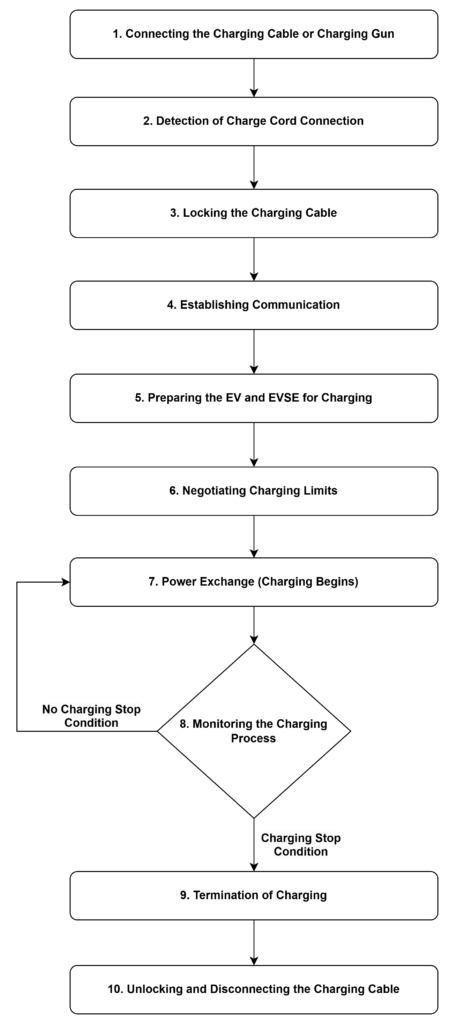EV Charging Sequence: Comprehensive Overview
Electric Vehicle (EV) charging follows a systematic sequence to ensure safe, efficient, and reliable energy transfer. Regardless of whether the charging is AC or DC, the fundamental steps remain the same. This article provides a comprehensive breakdown of each step in the EV charging process.
Note: Specific charging sequences for each charging standard will be discussed in separate articles. This article provides an overview of the general steps involved in any charging sequence.

1. Connecting the Charging Cable or Charging Gun
The charging process begins when the user physically connects the charging gun or cable to the EV’s charging inlet. The type of connector varies depending on the charging standard being used:
- AC Charging: Type 1 (J1772) or Type 2 (Mennekes) or GBT AC or NACS (Tesla)
- DC Charging: CCS (Combined Charging System), CHAdeMO, GBT DC, or NACS (Tesla)
Ensuring a firm and secure connection is crucial to prevent charging interruptions or safety hazards.
2. Detection of Charge Cord Connection
Once the connection is made, both the EV and the Electric Vehicle Supply Equipment (EVSE) perform checks to confirm a proper connection.
a. Detection by EV
- The EV detects the presence of a connected charging cable using proximity and pilot signals.
- Some EVs verify the type of charging being initiated (AC or DC) and adjust internal systems accordingly.
- Once the charge cord connection is confirmed, the EV does not allow driving to prevent accidental movement, ensuring both user safety and protection of the charging infrastructure.
b. Detection by EVSE
- The EVSE also determines whether a vehicle is properly connected using proximity and pilot signals.
3. Locking the Charging Cable
To enhance safety and prevent accidental disconnection, the charging cable is automatically locked in place. Locking mechanisms can be found on the vehicle’s charging port or charging gun. This step ensures stable power transfer throughout the charging session.
4. Establishing Communication
A critical aspect of EV charging is the exchange of information between the EV and the EVSE. This communication occurs through industry-standard protocols such as:
- IEC 61851 (Basic communication via PWM signals)
- ISO 15118 (Advanced communication, enabling Plug & Charge authentication)
- DIN 70121 (Specific to DC fast charging)
- GB/T 27930
- CHAdeMO
During this phase, the EV and EVSE exchange authentication details, charging capabilities, and other parameters necessary for safe operation.
5. Preparing the EV and EVSE for Charging
Before power transfer begins, both the EV and the EVSE perform a series of safety and readiness checks:
- The EVSE ensures there are no faults in the charging circuit.
- The EV assesses its battery status, Isolation status, and thermal conditions.
- The charging session is only allowed to proceed if both systems confirm readiness.
6. Negotiating Charging Limits
The EV communicates its charging requirements, Maximum Voltage & Current, defined by the battery’s charging capacity.
Simultaneously, the EVSE provides information about its capabilities, ensuring the charging power remains within safe operating limits.
7. Power Exchange (Charging Begins)
Once parameters are set, the actual power transfer begins.
- AC Charging: The onboard charger (OBC) inside the EV converts AC power from the EVSE to DC for battery storage.
- DC Charging: The EVSE supplies DC power directly to the battery, bypassing the onboard charger, allowing for faster charging.
The power flow is continuously regulated to match the EV’s battery characteristics.
8. Monitoring the Charging Process
Throughout the charging session, both the EV and EVSE actively monitor conditions to ensure safety and efficiency.
a. Monitoring for User-Defined Stop Conditions
- Users can manually stop charging via:
- A stop button on the EVSE
- Charging stop button on the EV charging inlet
- EV’s HMI
- A connected mobile app
b. Monitoring for Faults and Errors
Charging is constantly monitored for potential issues, such as:
- Overvoltage or undervoltage conditions
- Overcurrent or excessive power draw
- Thermal anomalies in the battery or charger
- Ground faults and electrical leakage
- Communication failures
If a fault is detected, charging is immediately halted to prevent damage to the vehicle or infrastructure.
9. Termination of Charging
Charging automatically stops when any of the following conditions are met:
- The EV battery reaches its maximum SOC level.
- The user manually stops the session.
- A fault or abnormal condition is detected.
- The charging station enforces a time or power limit.
Once charging is stopped, the power flow is halted, and the system ensures that no current flows in the cable.
10. Unlocking and Disconnecting the Charging Cable
The final step involves unlocking the charging connector, allowing the user to safely disconnect the cable. Before unlocking, several conditions are checked to ensure a safe disconnection:
- No active power transfer: The charging process must be fully stopped.
- No voltage at the charging inlet: There should be no active voltage at the charging inlet.
Once these conditions are confirmed:
- The vehicle unlocks the charging port.
- The user safely removes the cable.
The EV charging process is a carefully coordinated sequence designed to ensure safe, efficient, and seamless energy transfer between the charging infrastructure and the vehicle. Each step – from detecting the charging cable to power exchange and disconnection – relies on precise communication between the EV and EVSE. These safeguards not only enhance charging reliability but also protect the vehicle, user, and grid infrastructure from potential faults.
EV Charging Explained – Everything you need to know about Electric Vehicle Charging